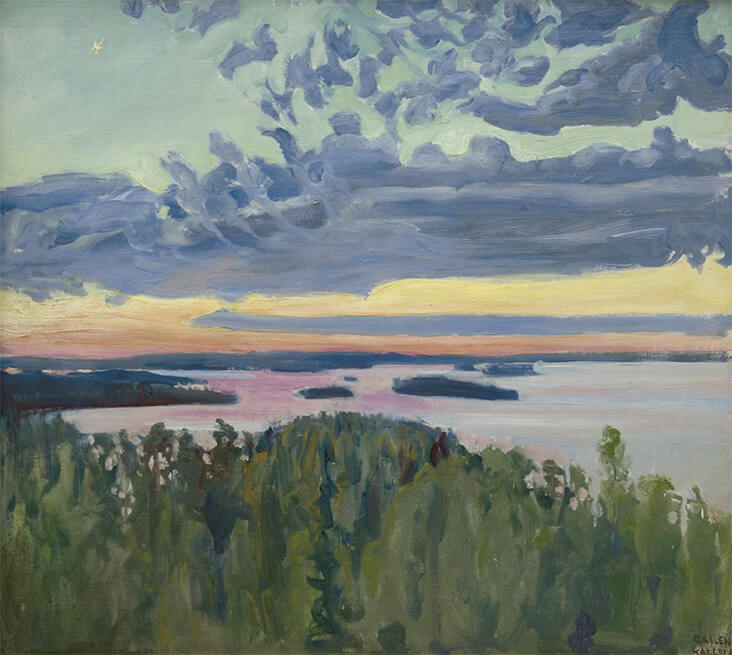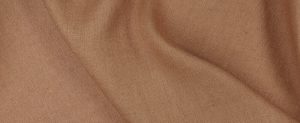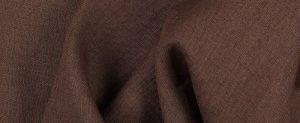GREY MIST inspired by Askeli Gallen-Kallela’s Watery Paradise
Askeli Gallen-Kallela painted his native Finland as a magical watery paradise, where icy lakes, bruised skies and mounds of snow are dappled with streaks of enigmatic blue shadow. The blue-tinged shade of GREY MIST Linen was one he would return to over and over to convey these darkening areas of cast shadow, invoking the ancient, mysterious spirits of Finnish folklore that are so closely tied with the landscape of his vast, picturesque homeland.
Born in Pori in western Finland under the name Axel Gallen, Gallen-Kallela developed a keen interest in nature from a young age. He began taking drawing classes in Helsinki in 1878, igniting a passion for art that was followed by academic art training in Paris at the Academie Julian and Atelier Cormon. There he was introduced to the work of French Realist painters and the power of ‘en plein air’ painting techniques for capturing the essence of momentary, transitory light. Although he spent five years training as a painter in Paris, Gallen-Kallela longed for his native Finland and returned whenever he had the chance, retreating to the countryside to paint what he called the ‘real’ Finland in amongst the glassy lakes, long grasses and damp overgrown forests.
Gallen-Kallela was particularly patriotic about Finnish history and much of his early art took inspiration from the Kalevala, a collection of ancient Finnish folklore stories about the creation of earth. One of his most successful early paintings was a triptych that conveyed the Kalevala story of The Aino Myth, which he made in 1888. It tells the story of Aino, who escapes an arranged marriage by jumping into a river and transforming into a shape-shifting water spirit. The atmospheric qualities of light in Gallen-Kallela’s dramatic tale mesmerised audiences, particularly the rippling blue lake water which seems to hold ancient mythical magic in its depths, and he was commissioned to paint a second version of the same subject for the Finnish state in 1881.
Gallen-Kallela’s life in the years that followed was nomadic as he wandered throughout Europe, and later Russian and Africa, which only served to deepen a patriotic passion for his native homeland. Between 1904 and 1906 Gallen-Kallela made a series of paintings of Lake Keitele in central Finland, each capturing the naturally occurring zigzagged pattern of silver stripes on the water’s surface as wind interacts with water currents, shattering the glassy mirror-like shine of entrancing blue water. These zig-zags were also historically associated in Finland with the Kalevala’s central character of Vainamoinen, who was said to leave these traces on lake water as he travelled across its surface. It is no coincidence that Gallen-Kallela made these paintings at a time when Finland was fighting for independence; they are recognised today as potent symbols of Finnish nationalism and pride.
Made in the same year, View Over a Lake at Sunset, 1905 is a quieter scene as evening gradually sets in, and clouds overhead are heavy with deep lilac and blue shadows that loom over the translucent water below. Finnish Spring Sun at Konginkangas, 1906 captures another fresh scene from the Finnish wilderness, this time in a quiet corner of forestry heavily laden with snow, made magical as a shaft of sunlight streaks through the slim, leafy trees, casting hypnotic grey and blue shadows across the crystal white ground.
In the later painting Lake Ruovesi in Winter, 1916, one of Finland’s most famous lakes is completely encased in ice and snow, forming an expansive sheath of white that dominates the entire scene and gleaming sunlight from the cloudless blue sky illuminates its surface with a blinding brightness. Bold blue and lilac shadows bristle across the foreground, filled with atmospheric weight, which could just as easily be cast by trees, people, or the passing spirits from Finland’s ancient, enduring history.











































One Comment
Elaine Rutledge
My Bleached 4C22 arrived today! It looks wonderful. I will be using it to experiment with hand painted placemats to match my IL019 table linens. Also in the queue, 2 yards, different colors of doggie bag grey IL019. They could be table napkins, but as an artist, I am beginning a series of what you can do with multiples of 1 yard “doggie bags.” Since my retirement I do love the luxury of playing with my passion for linen. Soon I will ‘catch up’ with posting my results. Am working on it. At age 77, I am slower than the snail who rides atop my pet turtle. “All good things come to those who wait…”